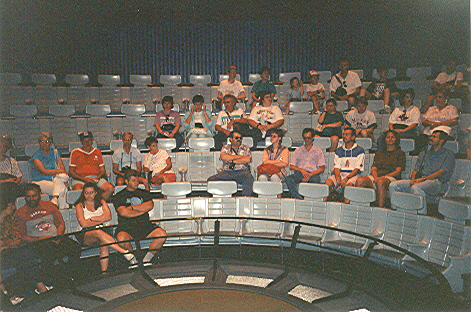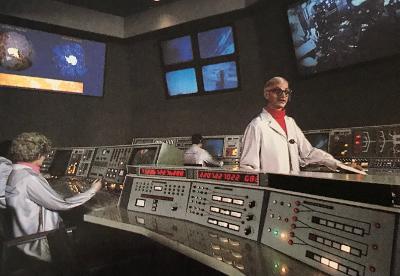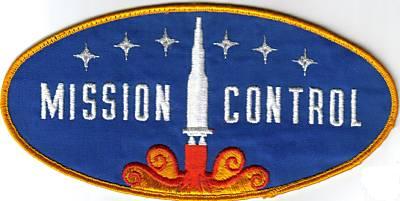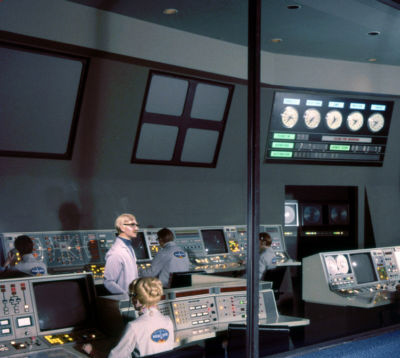Walt Dated World: Vintage Disney World | home
America the Beautiful Circle-Vision 360 Film | American Journeys Circle-Vision 360 Film | Disney's Carousel of Progress: The Best Time of Your Life | Delta Dreamflight/Take Flight at Walt Disney World | Flight to the Moon at Walt Disney World | Grand Prix Raceway at Walt Disney World | If You Had Wings/If You Could Fly at Walt Disney World | Magic Carpet 'Round the World Circle-Vision 360 Film | Mission to Mars at Walt Disney World | Tomorrowland Shops and Restaurants | Skyway To Fantasyland From Tomorrowland | Space Mountain (Former Sponsors) at Walt Disney World | Tomorrowland Star Jets at Walt Disney World | Timekeeper Circle-Vision Film at Walt Disney World | WEDway PeopleMover at Walt Disney World
Mission to Mars at Walt Disney World
Mission to Mars

(Photo courtesy of Brotherdave.)
Mission to Mars was developed in cooperation with NASA and it premiered June 7, 1975. The preshow area included a Mission Control with Audio-Animatronic space technicians that was similar to the ones from Flight to the Moon but Mr. Tom Morrow was now named Mr. Johnson. During Mr. Johnson's briefing, there was a "possible emergency reentry" situation but it turned out to be a wayward bird. This element was held over from the Flight to the Moon preshow.
Both shows had guests enter one of two cabins, where they sat in a circular arrangement. After the liftoff, (The Birnbaum Disney guide likened the sounds heard during the launch in Mission to Mars to "a washing machine during the spin cycle".) the seats caused the passengers to feel the effect of increased G forces and the lack of gravity. Screens on the floor and ceiling showed guests what was happening outside of the ship. The ship would enter "hyperspace" during the Mission to Mars years and launch probes to show the Martian landscape up close. A meteor shower then damaged the ship, forcing an emergency landing.
All it took to get to Mars was a D ticket but you were out of luck once the ride closed on October 4, 1993. Mission to Mars was replaced by Alien Encounter, which was in turn replaced by Stitch's Great Escape! in 2004.
Mission to Mars Script
(This transcription is courtesy of Eric Paddon.)
(Disneyland used the flight number 295 in its version of the ride . However, the signage at Walt Disney World during "Flight To The Moon" and "Mission To Mars" always referred to the flight number as 92, even though the audio track always referred to Disneyland Flight 295. For a long time, there was no indication that the audio tracks at Walt Disney World redubbed this to Flight 92 at any time during the ride's history at the park. Eric Paddon finally discovered the following: "I have finally seen confirmation from the video put out by Jeff Lange that Walt Disney World did in fact change the signage from Flight To The Moon's Flight #92 to Flight #295 for Mission To Mars to match the audio soundtrack that refers to "Flight #295".)
Mission Control Preshow
Cast Member (Live): Ladies and Gentlemen, may I have your attention please? When we leave this area in a moment, be sure to take along all your belongings, including, your imagination. Our Mission to Mars takes place sometime in the future, when a sightseeing trip to the red planet is a everyday adventure. When you enter, please use all three aisles, keep your group together, and move as far toward the end as you can.
(Passengers follow cast member down hallway and come to Mission Control, which they look down into and see numerous Audio-Animatronic technicians at various stations. Standing in the center, in white coat and red turtleneck with horn-rimmed glasses, is the figure of Operations Director Mr. Johnson.)
Cast Member (Live): Ladies and gentlemen, this is our McDonnell-Douglas Mission Control room at Disneyland Spaceport. The Director of Operations has been expecting you, and while we're waiting for our flight to be called, he'll take a few minutes to describe what's going on. Excuse me? Mr. Johnson? All the passengers for Flight 295 are now in the boarding area.
(Mr. Johnson turns around to face the people.)

(Many people noticed that Mr. Johnson's face looked very similar to the father's from Carousel of Progress. He had a moustache in the Walt Disney World version of the show and was clean-shaven at Disneyland!)
Mr. Johnson: Thank you. Welcome to Mission Control, space travelers. The first part of your trip to Mars today will be directed from this room, and so will your landing when you return to Earth. (Turns around to face large monitors on the board.) As you can see on the large screen behind me, we're keeping track of things on one of our many manned space stations now in orbit. While the small screens below show other activities being monitored by Mission Control. I'll have them repeated on the upper screens for you also.
Astronaut Voice: SSL, this is instrumentation.
Mission Control Voice: Roger. SPO, starting port records and TV video tape recorders.
Astronaut Voice: Wilco.
(Image of astronaut at work on space station fills screen.)
Mr. Johnson: Now on the large screen again, you see a scientist aboard the space station at the controls of a large telescope trained on the sun. This kind of solar research was begun back in the early 1970s by the Skylab astronauts. And time-lapsed pictures from space like this are revealing new facts about how the sun produces energy, which may help us solve some of our own energy problems on Earth. (New image fills screen.) This is a very interesting part of the station. Where special manufacturing processes are carried out under weightless conditions. (Main screen now shows scientific experiment demonstration.) Here you see a close-up picture of a groove being melted in a stainless steel plate. Done in Zero G conditions, this imparts a quality to the metal we can't get under Earth gravity.
Astronaut Voice: Ah, Mission Control, this is Space Lab zero-niner, stand by for new video on B channel.
Mr. Johnson: And now through an onboard microscope and time-lapse camera, we can see the way crystals form in Zero G.
Astronaut Voice: Ah, Capcom, this is Space Lab o-niner. Request you transmit this recording to crystallography lab console, over.
Capcom (Capsule Communicator): Zero-niner, this is Capcom. Roger your request. Relay coming up will be via Goldstone (This was a reference to a real-life tracking station). Capcom out.
Astronaut Voice: Zero-niner out.
Mr. Johnson: These space-grown crystals are so pure that they're going to bring revolutionary advances in electronics, which will benefit everyone of us. In fact, they're so-
(Alarms sound and flashing lights fill Mission Control. The monitors suddenly grow snowy.)
Mission Control Voice: Attention! Clear all channels for possible emergency re-entry!
Mr. Johnson: Oh no, not again!
Mission Control Voice: Stand by! Video signal coming in on all channels.
(Each monitor in Mission Control now shows an awkward looking albatross coming in for a landing.)
Mr. Johnson: Just as I thought. Somehow this silly bird trips the emergency system every time he comes in. And I think he knows the laugh's on us.
Cast Member (laughing): Oh Mr. Johnson, would you show us what it's like for people in zero gravity? That's very interesting. (If the live Cast Member wasn't present for this part of the show, a pre-taped voice with the same question would then kick in.)
Mr. Johnson: Of course, just a moment. (Turns to technician.) Patch us into Skylab video-net please.
Astronaut Voice: Roger, Mission Control. (New images on screen.)
Mr. Johnson: Now there you see how easy it is, to get from one place to another. You simply float through the air. That takes some getting use to. But Zero G has other advantages too. Like this for example, one man can easily handle heavy pieces of scientific equipment, that he couldn't even move under normal gravity. (New film of astronauts in exercise mode.) Astronauts quickly adapt to Zero G, but over extended periods, regular exercise is absolutely vital. Here are some off duty crew members working out in the station's gymnasium.
Flight Surgeon: This is JSC Medical, MX leads are now being monitored on channel 27. For this exercise period, all ECGs normal. Heart rate - 120 plus.
Mr. Johnson: It's fun, but it isn't always as easy as it looks as you can see. With a little practice though, you can do tricks that would make a circus acrobat turn green with envy.
Female Technician: All personnel, switch to channel number two for status check.
Male Technician #1: Core communications status is go. Global network status is go.
Female Technician: Instrumentation?
Male Technician #2: Instrumentation go.
Female Technician: Propulsion?
Announcer (above technicians cross-talk): Disneyland Flight two-nine-five to Mars is now ready for boarding at gate number three.
Male Technician #3: Go. (The image of the Mars spacecraft now fills the main viewing screen.)
Mr. Johnson: Now on the large monitor, you can see your spacecraft, waiting on the launch pad. Count down is in progress, and all systems are go. Have a good flight.
Cast Member (live): Thank you, Mr. Johnson. Ladies and Gentlemen, please follow me to the boarding gate.
(Passengers follow the Cast Member out of Mission Control area through doors that lead to "spaceship" seating.)
Mission to Mars Main Show
(Passengers seat themselves in circular theater. There are screens on either side of the room, with main screens in the floor and ceiling.)
Cast Member (Live): Ladies and Gentlemen, welcome aboard our McDonnell-Douglas DC-88 space liner for today's Mission to Mars. The captain has asked that you remain in your seats at all times. And please, no smoking. (McDonnell-Douglas sponsored the attraction briefly in the late 1970s, the only time the attraction had sponsorship at Walt Disney World)
Third Officer Collins: Attention please. Folks, this is Third Officer Collins speaking, I'm your tour guide today and I'll be telling you about what's going on during the trip. Right now we're on final countdown, and you can watch our lift off on the lower screen in your cabin. I'll speak to you again after we're in space. (Third Officer Collins was voiced by Disney park veteran Pete Renaday.)
Captain: Mission Control, this is Mars two-niner-five, ready for departure.
Mr. Johnson: Two-niner-five, Roger. Countdown is go in T-minus 5, 4, 3, 2, 1. Ignition!
(On the lower screen we see the liftoff and feel our seats sink, simulating the g-factor. The upper screen shows the Moon coming into view. This film footage of the liftoff and the Moon overhead dated all the way back to the original Disneyland "Rocket To The Moon" ride in 1955!)
Mr. Johnson: Mars two-niner-five, auto-control is terminated. You are cleared for hyperspace penetration. Good Luck!
Captain: Two-niner-five.
(A loud popping sound emits as we feel our seats suddenly rise back up underneath. On the side screen, we see the lower stage of the rocket being jettisoned.)
Collins: Ladies and Gentlemen, we've just dropped our booster engines and in a moment we'll make what we call a hyperspace jump, the new method of space travel which enables us to cover enormous distances in seconds. (The side screens now show new diagrams.) On the side screens, our ship's computer has drawn a diagram of our solar system, and we'll tip it over and move in closer so you can see where we're going. You'll notice that the orbital velocity of the planets is exaggerated, but as we approach the inner planets, you can see that they move with the proper relative speeds. (The orbital paths of Earth and Mars are now shown.) Earth and Mars are anywhere from 35 million to 240 million miles apart at times. Which used to make a trip to Mars pretty tricky. For example, space ships had to follow a curved path for about eight months to intercept Mars when it reached a certain spot. (Chuckles.) It was like trying to hit a golf ball in California hard enough, and accurately enough, to make it go through one particular window of a train arriving in Florida that much later. (New diagrams and visuals demonstrating hyperspace.) Today it's much easier. We simply launch out into space, until we reach Mars Acquisition Velocity, or MAV. Then we generate a hyperspace field around us for a short time. When we switch it off, our space craft is approaching Mars. Back in the 1970s and 1980s, this would have seemed like science fiction, but today it's routine. And we-
Captain: Attention all stations. Hyperspace penetration now commencing. Secure all ship operations.
(Top and bottom screens show light effects of hyperspace jump. The side screens flash the message "Hyperspace Penetration" . When it ends, the top screen shows Mars.)
Captain: All stations, we are now in normal space mode. Resume all operations.
Collins: Well, folks, a hyperspace jump is always interesting, to say the least, but we're back in the real universe again, and on the upper screen you can see Mars as it actually appears close up. The dark markings were once thought to be vegetation but they're actually just large areas where rocky surface material has been swept clear of top soil by high winds. Mars does have a very thin atmosphere but it contains no oxygen. There's no liquid water at all, and temperatures are far below zero over most of the planet.
Captain: Attention all stations. Outer lock is now open. Standby to launch camera drones.
(Two camera ships zoom into view across the upper screen.)
Collins: Those small unmanned rocket ships you see leaving us will shortly be sending back television pictures as they fly near the surface. But we'll continue our view from orbit also. (The upper screen now shows a more close view of the Martian surface.) Through telescopic lenses, Mars looks even more barren. And there's definitely no sign of it being inhabited. As we now know now, some things once thought to exist on Mars turned out to be only illusions, such as the famous Martian canals. But it does has some natural features that are almost as amazing. (New image on upper screen.) For example, this gigantic rift in Mars's surface called Mariner Valley; it's over three thousand miles long, ten times bigger than the Grand Canyon back home. And for a planet that's only half the size of Earth, that's pretty impressive. (Outline of Continental US appears over the image on upper screen.) This superimposed outline of the United States will give you an idea of its size. (Close-up image now appears on upper screen.) Here's a closer view of the section of the rift one of our camera craft is approaching. In a few seconds, we'll have the picture it's sending back, so watch the side screens, please. (Side screens now show same image of the mountainous rift from the camera ship's perspective.) There's the picture. Our camera ship is down in the rift now. Seeing this close, it looks quite Earth-like, but it's hard to get the scale of things. The wall there is almost four miles high, and the floor is about fifty miles across at this point. Even those branch canyons you see are six or seven miles wide and go back as much as one hundred miles from the main rift. This is no little canal by any means. (New image on upper screen showing a conical shape peak.)
On the upper screen we're switching to what is literally the high point of Mars. Olympus Mans, the biggest volcano in the whole universe, as we far as we know now. It's 370 miles wide at the base and over 75,000 feet high at the top. Two and a half times more then Mt. Everest, the highest point on Earth. (New images on side screens.) Now on the side screens, is the picture from our other ship as it approaches the top of the cone. In just a moment it will drop down in the caldera, and you can see how big it really is. On Earth, the largest calderas are up to ten miles across, but that's forty miles to the opposite rim. Olympus appears to be extinct now, but just imagine what it was like when that entire area was a sea of boiling lava.
Scientists estimate that- (The image on the side screen abruptly shakes. A warning beeper sounds.) Just a moment, please.
Operations: Space Con, we show a lost of signal on remote two. Impact count is rising.
Collins: Ladies and gentlemen, our camera ship has been knocked out of control by a shower of meteoritic particles. We may encounter the same conditions and- (Flashing lights and sirens now fill the theater. Looking at the upper screen, the image of the Martian surface is gone indicating the ship has been knocked violently off course.)
Operations: Space Con, this is Operational. We have damage to primary ACS.
Captain: Emergency! Standby for space warp!
Collins: Ladies and gentlemen, we're returning to Earth immediately. Be prepared for another space jump.
(Hyperspace jump. When it ends, the top screen shows the Moon and the lower screen the rapidly approaching Earth.)
Captain: Mission Control, this is Mars two-niner-five, we're terminating emergency space warp. Are we cleared straight in?
Mr. Johnson: Two-niner-five, this is Mission Control. Affirmative your last transmission. You are priority one for descent, auto-control is locked on, and we are counting to retro-fire.
Captain: Two-niner-five.
Collins: Ah, ladies and gentlemen, (chuckles sheepishly) as you can see, we'll be on the ground soon. Everything's all right now, but ah, that was a close call. Actually the chances are a million to one against meeting another emergency like that, so please fly with us another time. There's a lot more to see on Mars. Now, please stand by for touchdown.
(Roaring sound as the ground comes into view. Then, the images on the lower and upper screens disappear as the lights come on and the sound of the engines fade out.)
Cast Member (Live): Ladies and gentlemen, the outer locks are now open and you may leave the spacecraft. Thank you for flying McDonnell-Douglas today, and we hope to see you again
soon.
Alternate Show Script
Early in the show's run, there was an earlier main show script than the one listed below. During the main show, an "in-flight" film titled Mad Martian Myths was shown that depicted some of the lifeforms that had been imaged to live on Mars. The footage was recycled from the Ward Kimball-directed Disneyland show Mars and Beyond that aired on December 4, 1957. The version of the show featuring these clips most likely lasted only a few months. The landing of the Viking 1 and Viking 2 probes in 1976 (and the Martian-free pictures they transmitted back) most likely led to film being deleted during this time.
Attraction Tributes
When riding the TTA from 1994-2009, the following announcement could be heard: "Paging Mr. Morrow. Mr. Tom Morrow. Your party from Saturn has arrived. Please give them a ring." A "Mr. Johnson" was also heard giving a traffic report on the TTA. The Mr. Johnson Audio-Animatronics figure was reused for both SIR in Alien Encounter and then later became Sarge in Stitch's Great Escape!
Alien Encounter also contained a reference to the attractions. The TV screen in the holding queue showed upcoming events at the Tomorrowland Interplanetary Convention Center. A lecture called "Mission to Mars: History or Hoax?" given by Tom Morrow was listed as coming soon.
At the exit of Space Mountain, the robot at the desk has a screen containing multiple tributes to past attractions, including a code "TL-M2M" for Mission to Mars. The Jungle Navigation Co. Ltd. Skipper Canteen contains bookshelf that has the book Mission to the Red Planet by "Morrow".
Epcot and the Studios also contain tributes to the shows. Innoventions at Epcot is hosted by an Audio-Animatronics figure named Tom Morrow 2.0 while the Star Tours attraction pages Mr. Tom Morrow.
Mission Control Patch
Jason Rubin sent this picture of a Mission to Mars Mission Control patch. You can see it on the back of one of the Audio-Animatronic Mission Control figures in the picture below.


Please show your support for this site by donating via the PayPal box. Thank you!
This is an unofficial fan site that is not affiliated with the Walt Disney Company or Disney theme parks. All copyrights acknowledged. Please respect the work I put into compiling both existing and my own information on this site by not linking to any text or pictures without crediting that they were located on this site.
See ya real soon!